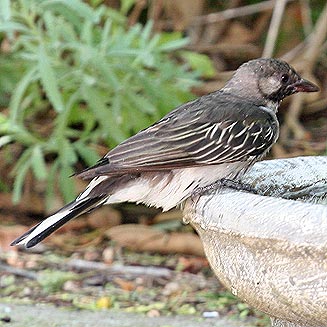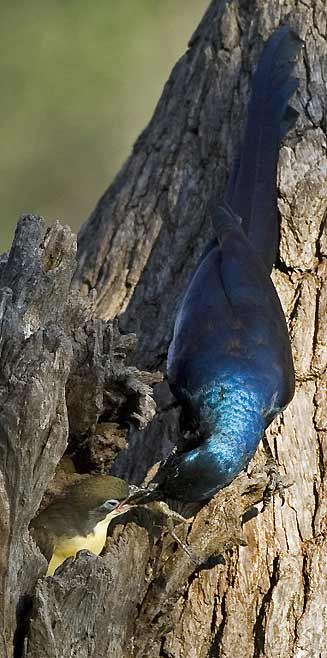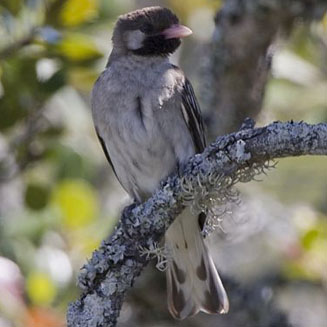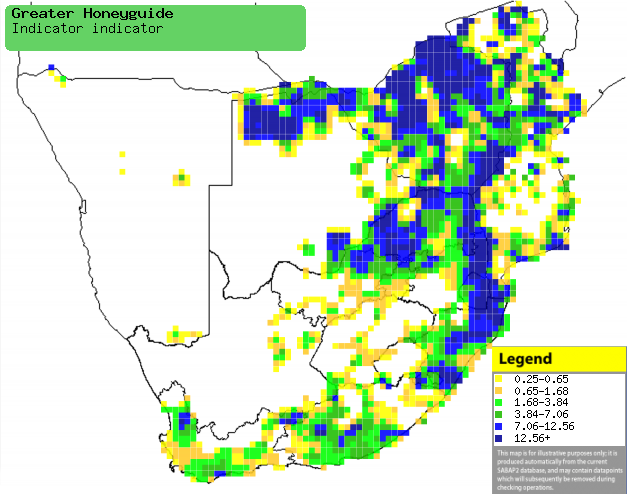|
Indicator indicator (Greater
honeyguide)
Grootheuningwyser [Afrikaans]; Intakobusi (generic term
for honeyguide) [Xhosa]; iNgede, iNhlavebizelayo, uNomtsheketshe [Zulu]; Kasoro
(generic term for honeyguide/honeybird) [Kwangali]; Tsehlo, Molisa-linoti
[South Sotho]; Tshetlo [North Sotho]; Mukaranga, Shezhu, Tsoro [Shona]; Inhlava
(generic for honeyguides) [Swazi]; Nhlalala (generic term for honeyguide)
[Tsonga]; Tshetlho [Tswana]; Grote honingspeurder [Dutch]; Grand indicateur
[French]; Großer honiganzeiger, Schwarzkehl-honiganzeiger [German];
Indicador-grande [Portuguese]
Life
> Eukaryotes >
Opisthokonta
> Metazoa (animals) >
Bilateria >
Deuterostomia > Chordata >
Craniata > Vertebrata (vertebrates) > Gnathostomata (jawed
vertebrates) > Teleostomi (teleost fish) > Osteichthyes (bony fish) > Class:
Sarcopterygii (lobe-finned
fish) > Stegocephalia (terrestrial
vertebrates) > Tetrapoda
(four-legged vertebrates) > Reptiliomorpha > Amniota >
Reptilia (reptiles) >
Romeriida > Diapsida > Archosauromorpha > Archosauria >
Dinosauria
(dinosaurs) > Saurischia > Theropoda (bipedal predatory dinosaurs) >
Coelurosauria > Maniraptora > Aves
(birds) > Order: Piciformes >
Family: Indicatoridae
 |
 |
|
 |
|
Top left: Greater honeyguide, West Coast Fossil Park,
Western Cape, South Africa. [photo H. Robertson, Iziko ©}
Bottom left: Greater honeyguide, De Hoop Nature
Reserve, South Africa. [photo
Trevor Hardaker ©] |
Greater honeyguide chick, being fed a
frog by a
Meve's starling. [photo Johann du Preez ©] |
The Greater honeyguide occurs from Senegal through the Sahel to Ethiopia, extending south to many areas of southern Africa, where it
lives in a wide variety of habitats. It mainly eats bees' products, and is
famous for its tendency to lead humans to bees nests. It is a brood parasite,
laying in a wide variety of bird nests. The female lays its egg while the hosts
is out, destroying any existing eggs already in the nest. The eggs are laid in series
of 4-7, each in a different nest, laying about 21 eggs in the whole
breeding season. The chicks stays in the nest for roughly 38 days, after
which they are fed by the host for 7-30, usually 7-10 days after leaving.
Distribution and habitat
It occurs across sub-Saharan Africa; in southern Africa it
occupies Zimbabwe, Botswana, Mozambique and
the non-arid areas of South Africa.
It can survive in a wide range of habitats, such as woodlands, savanna, fynbos,
grassland, riverine forest, rarely moving into miombo and Baikaiea plurijuga
(Zambezi teak) forests. Its population has recently increased in the Western
Cape, probably due to tree planting (see Conservation).
|
 |
|
Distribution of Greater honeyguide in southern Africa,
based on statistical smoothing of the records from first SA Bird Atlas
Project (©
Animal Demography unit, University of
Cape Town; smoothing by Birgit Erni and Francesca Little). Colours range
from dark blue (most common) through to yellow (least common).
See here for the latest distribution
from the SABAP2. |
Food
It mainly eats the products of bees,
such as eggs, larvae and wax, as well as termite alates and other insects.
Honeyguides are the only African birds that are able to eat beeswax (a practice known as cerophagy), as they have symbiotic micro-organisms that digest it. Like certain
other honeyguides, it guides mammals to bees nests. Interestingly, it is known
to only guide humans, although some consider
Mellivora capensis
(Honey badger) to also be guided, although there is no evidence to support this.
It is thought that it might of evolved its guiding ability with the early
humans, as there is much folklore surrounding the relationship between humans
and the Greater honeyguide, including the myth that it sometimes leads humans to
predators. It usually attracts one's attention by chattering loudly, before
flying with exaggeratingly undulating flight to a perch about 40 m away. It then
watches and awaits for one to come to it, repeating this until it reaches
the hive. If it is not followed then it flies back, trying to attract
one's attention again. The following food items have been recorded in its diet:
- Bees and their products
- Other insects
Breeding
- It is a brood parasite, meaning that it lays its eggs
in other bird nests, which are usually barbets. The host, thinking that the
egg is its own, incubates the egg and cares for the chick. The following
bird species are known hosts of the Greater honeyguide:
- Egg-laying season is from September-January, peaking from
September-October.
- The female lays its egg while the host is not around, destroying any existing
eggs already in the nest. The eggs are laid in series
of 4-7, each in a different nest, laying about 21 eggs in the whole
breeding season.
- The chicks stays in the nest for roughly 38 days, after which they are
fed by the host for 7-30, usually 7-10 days. Interestingly,
the host bird sometimes feeds the fledgling honeyguide, but then attacks it
when it flies off!
Threats
Not threatened, in fact its range in southern Africa has
increased recently, due to the establishment of man-made woodland habitats.
References
-
Hockey PAR, Dean WRJ and Ryan PG (eds) 2005. Roberts
- Birds of southern Africa, VIIth ed. The Trustees of the John Voelcker
Bird Book Fund, Cape Town.
|
